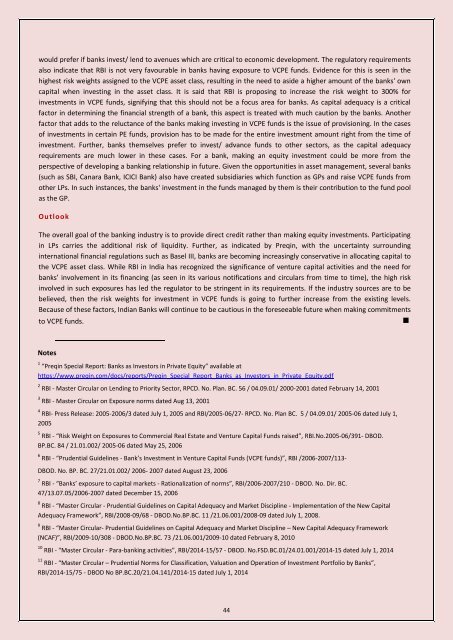Past Reports
2014vcpa
2014vcpa
Create successful ePaper yourself
Turn your PDF publications into a flip-book with our unique Google optimized e-Paper software.
would prefer if banks invest/ lend to avenues which are critical to economic development. The regulatory requirements<br />
also indicate that RBI is not very favourable in banks having exposure to VCPE funds. Evidence for this is seen in the<br />
highest risk weights assigned to the VCPE asset class, resulting in the need to aside a higher amount of the banks' own<br />
capital when investing in the asset class. It is said that RBI is proposing to increase the risk weight to 300% for<br />
investments in VCPE funds, signifying that this should not be a focus area for banks. As capital adequacy is a critical<br />
factor in determining the financial strength of a bank, this aspect is treated with much caution by the banks. Another<br />
factor that adds to the reluctance of the banks making investing in VCPE funds is the issue of provisioning. In the cases<br />
of investments in certain PE funds, provision has to be made for the entire investment amount right from the time of<br />
investment. Further, banks themselves prefer to invest/ advance funds to other sectors, as the capital adequacy<br />
requirements are much lower in these cases. For a bank, making an equity investment could be more from the<br />
perspective of developing a banking relationship in future. Given the opportunities in asset management, several banks<br />
(such as SBI, Canara Bank, ICICI Bank) also have created subsidiaries which function as GPs and raise VCPE funds from<br />
other LPs. In such instances, the banks' investment in the funds managed by them is their contribution to the fund pool<br />
as the GP.<br />
Outlook<br />
The overall goal of the banking industry is to provide direct credit rather than making equity investments. Participating<br />
in LPs carries the additional risk of liquidity. Further, as indicated by Preqin, with the uncertainty surrounding<br />
international financial regulations such as Basel III, banks are becoming increasingly conservative in allocating capital to<br />
the VCPE asset class. While RBI in India has recognized the significance of venture capital activities and the need for<br />
banks’ involvement in its financing (as seen in its various notifications and circulars from time to time), the high risk<br />
involved in such exposures has led the regulator to be stringent in its requirements. If the industry sources are to be<br />
believed, then the risk weights for investment in VCPE funds is going to further increase from the existing levels.<br />
Because of these factors, Indian Banks will continue to be cautious in the foreseeable future when making commitments<br />
to VCPE funds.<br />
•<br />
Notes<br />
1 “Preqin Special Report: Banks as Investors in Private Equity” available at<br />
https://www.preqin.com/docs/reports/Preqin_Special_Report_Banks_as_Investors_in_Private_Equity.pdf<br />
2 RBI - Master Circular on Lending to Priority Sector, RPCD. No. Plan. BC. 56 / 04.09.01/ 2000-2001 dated February 14, 2001<br />
3 RBI - Master Circular on Exposure norms dated Aug 13, 2001<br />
4 RBI- Press Release: 2005-2006/3 dated July 1, 2005 and RBI/2005-06/27- RPCD. No. Plan BC. 5 / 04.09.01/ 2005-06 dated July 1,<br />
2005<br />
5 RBI - “Risk Weight on Exposures to Commercial Real Estate and Venture Capital Funds raised”, RBI.No.2005-06/391- DBOD.<br />
BP.BC. 84 / 21.01.002/ 2005-06 dated May 25, 2006<br />
6 RBI - “Prudential Guidelines - Bank’s Investment in Venture Capital Funds (VCPE funds)”, RBI /2006-2007/113-<br />
DBOD. No. BP. BC. 27/21.01.002/ 2006- 2007 dated August 23, 2006<br />
7 RBI - “Banks’ exposure to capital markets - Rationalization of norms”, RBI/2006-2007/210 - DBOD. No. Dir. BC.<br />
47/13.07.05/2006-2007 dated December 15, 2006<br />
8 RBI - “Master Circular - Prudential Guidelines on Capital Adequacy and Market Discipline - Implementation of the New Capital<br />
Adequacy Framework”, RBI/2008-09/68 - DBOD.No.BP.BC. 11 /21.06.001/2008-09 dated July 1, 2008.<br />
9 RBI - “Master Circular- Prudential Guidelines on Capital Adequacy and Market Discipline – New Capital Adequacy Framework<br />
(NCAF)”, RBI/2009-10/308 - DBOD.No.BP.BC. 73 /21.06.001/2009-10 dated February 8, 2010<br />
10 RBI - “Master Circular - Para-banking activities”, RBI/2014-15/57 - DBOD. No.FSD.BC.01/24.01.001/2014-15 dated July 1, 2014<br />
11 RBI - “Master Circular – Prudential Norms for Classification, Valuation and Operation of Investment Portfolio by Banks”,<br />
RBI/2014-15/75 - DBOD No BP.BC.20/21.04.141/2014-15 dated July 1, 2014<br />
44


